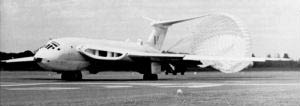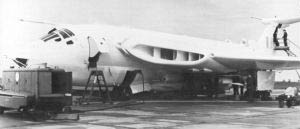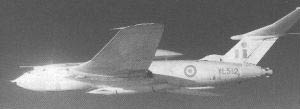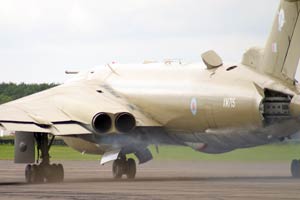Handley Page Victor - Memories
The following is kindly contributed by Tom Muir, an ex-RAF instrument fitter, with additional notes marked thus from Roger Brooks of the HP Association.
The other day whilst browsing through some old documents I came across my old Royal Air Force Service Record and noted the time I had served with 139 (J) Sqdn at RAF Wittering. My curiosity aroused, I surfed the Net and found your web pages on the Handley Page Victor. Well, did the memories ever come flooding back! There before my eyes were pictures of some of the very aircraft which probably still bear the scars of my screwdriver and which played such a large part in my life.
I have noted that most of the information is related to the Victor's tanker role and that little seems to be known or documented about their first and most exciting role as V-Bombers. For your interest I offer the following reminiscences of a youthful RAF Instrument Fitter from the early 1960s.
Having completed training at RAF Melksham as a direct entry Instrument Fitter (General) in December of 1961, I was posted to RAF Wittering to join a re-formed 139 (Jamaica Squadron) in January 1962. On arrival I found that we had a beautiful new hangar, a full complement of staff, but no aircraft! With all our servicing bays, stores etc. organised, it was with great anticipation that we all gathered out on the perimeter track to watch the arrival of our first aircraft (early February 1962, I think). Out of the clouds and in over the A1 she came, heartstoppingly graceful, XL231! Textbook touchdown, brake chute billowing, anti-flash white paintwork gleaming. She looked new, smelled new, and we were so proud of her.
Others followed in quick succession through 1962 and, as far as I remember,
in the following order:-
XL231, XL163, XL513, XL232, XM716, XM715, (XL190, XL191 I think).
Highlights of 1962 were the arrival of our aircraft and a goodwill trip to Jamaica to show those good people "their Squadron". For those who are unaware of the history, my understanding is that during World War 2, the people of Jamaica donated funds to buy bombers (Beaufighters or Blenheims I think) for the Royal Air Force. In recognition the new squadron was named 139 (Jamaica Squadron) but it was disbanded after the War. During 1962 the Valiants were decommissioned at Wittering and the Victors took over the QRA (Quick Reaction Alert) role. Long periods of boredom punctuated by short periods of panic and frenzy for those who can remember those days! It was particularly tense during the Cuban missile crisis.

139 Squadron's first Blue Steel-capable B.2 lands at RAF Wittering, August 1963; MoD
In February 1963, a certain young newly-married airman was called back off his honeymoon to go on a goodwill trip to Mexico! 2 Victors and one Britannia to Mexico via the Azores and Bermuda. A week in Mexico City, demonstrating to El Presidente the wonders of British engineering, and then home via Nassau (Bahamas) and Goose Bay (Labrador). The temperature difference between Nassau and Goose Bay I will leave to your imagination. Suffice to say it was a mid-flight change from Tropical gear to Arctic gear!
1964/65 saw us joined by 100 Squadron also with Victor B Mk2s. I think it was during this time our aircraft were progressively taken away for retro-fitting and came back resplendent in their low level camouflage livery and wing-mounted "window" boxes. [100 Squadron reformed in May 1962. Some aircraft gained 'window' dispensers before camouflage; XL513 was the first aircraft to be camouflaged, in January 1964.]
Mishaps and tragedies included one of our aircraft running off the end of the runway at the A1 end, and the crash of a 100 Squadron aircraft with total loss of life at Barnack, a few kilometres from the end of the runway. [This was XM714, on 20th March 1964. Co-pilot F/L B. Jackson survived.]

Blue Steel-equipped B.2 being serviced at RAF Wittering; unknown origin
Life on the Squadron proceeded with the usual mix of pitot static leaks, fuel gauging system problems, de-icing spraying in the freezing dark (I can feel and smell it still!), MFS faults, INS faults, and all the Blue Steel challenges. I wonder if anyone remembers the infamous "Butt 4 Connector"? This was the main multi-pin umbilical connection between the aircraft and the Blue Steel missile and caused us no end of electrical continuity problems.
The days and nights were filled with Pre-flights, After-flights, Turn-rounds, oxygen re-fills (including the damned Artouste!), sea-boot socks, trog boots, smelly anoraks that could almost stand up by themselves, thunder bucket toilets at the Dispersals ('A' Flight particularly!), self-made midnight meals in the Mess, hours of poker and brag waiting for the kites to come back after 6 hour flights, missing tool tags, GS screwdrivers, loose-article checks, compass swings, exercise Mickey Finns, curly sandwiches left by the flight crew, full warm piss-tubes also courtesy of the flight crew (no problem, the Airframe Fitters had to handle that!), the yellow glow of the sodium lamps, brake chutes in the back hatch, endless hours cleaning the white paintwork of the engine doors with Basol, replacing a pitot head in the freezing dead of night, engine runs on the jet pan, oxygen truck bottle changes, the NAAFI wagon with its cracked-top custard tarts... the memories are endless.

Blue Steel-equipped B.2 XL512 in flight; via Zvi Kreisler
1966 brought more excitement when one of our aircraft [XL513], when returning from Australia, suffered a bomb-bay fire and had to land at Gan in the Maldives off the tip of India. A works team from Handley Page went out and re-wired the bomb-bay and we went out to service and check out all the aircraft systems. 5 weeks in the sun on a tropical island the highlight of which was listening to England winning the World Cup in the Sergeants Mess. From memory it was a very good (if somewhat alcoholic) night. Sergeant 'Clancy' Ross where are you now?? After a fire, re-wire, 5 weeks on the ground in tropical salt-laden air, there were many crossed fingers when she gingerly took to the air again. We must have done a reasonable job as she flew safely home none the worse for her ordeal.
Most frightening experiences?
- Marshalling a Victor B Mk2 (complete with drop tanks and Blue Steel)
into the Dispersal in a snowstorm in the dead of night. Not a job for the
fainthearted.
Picture the scene! A young lad still in his teens, a glowing wand in each hand, sleet slicing into his face, confronted by this huge, roaring, two-eyed monster bearing down on him, almost totally blinded by the landing lights, not sure whether the damned thing is going to stop or not! Is the pilot watching me? I can't see the lines on the concrete! I take a guess and cross the wands above my head! For one interminable moment nothing happens, it keeps coming! Then the nose dips and the monster comes to rest; the engine whine descends into silence and the only sound is the hum of the inverters from the plenum chamber. - Entering the bomb-bay with bomb-bay tank fitted when hydraulic power is
switched on!
So what? I hear you say.
The Victor bomb-bay tank was a fairly tight fit and the space between the tank and the bomb-bay doors was only about 18 inches. Access was via a small hatch through which one had to squeeze backwards and upwards between the tank and the doors before moving around to the front of the tank and freedom.
One's torso was half in and half out of that hatch for quite a time and, as the doors were hydraulically operated, the sound of the hydraulic pumps being switched on was absolutely terrifying! The thought of being neatly sliced in two by the doors opening certainly made one very athletic even with all the theoretical safety measures in place. - Being responsible for the fitting of the crew chief's intercom access
panel.
The crew chief is in contact with the flight crew via intercom which is accessed via a small hand-sized panel in the nose. This is the last panel to be closed prior to take-off and Murphy is always alive and lurking. Invariably, the more crucial the occasion (like QRA), the more likely is the panel to refuse to latch! There you are, the nuclear missiles are incoming from the East, your 4 Minute Warning is half gone, and you are holding up the western world's nuclear deterrent force fiddling with this little piece of aluminium!
The whole Squadron is watching you and the crew chief has fixed you with an icy glare as he coils up his intercom lead. Again, invariably, just as out of the corner of your eye you see the crew chief take a step towards you, the panel latches and the world starts again.
In November, 1966, I was posted to Singapore and, even after many more years working on all sorts from helicopters to Phantoms, the 5 years with the Victors were undoubtedly the highlight of my Service career. For me, the Victor is still the most elegant aircraft ever produced, and the sight and sound of them still makes the hair on the back of my neck stand on end!

K.2 XM715 at Bruntingthorpe, September 2002; author
For those who may read this and are interested, the following videos will take you back:-
- Salute the Victor by Flypast (Aviation Action)
- Handley Page by Aircraft Projects
- Marham Victors by Aviation Video International
- The Best of British Aviation
In the year 2000 my wife Mary (who was also stationed at Wittering) and I will visit UK for the first time since 1973 and you can be sure that a "must see" will be XL231 at the Yorkshire Air Museum, Elvington and XM715 at British Aviation Heritage, Bruntingthorpe.
If you anyone from the days I have recounted would get in touch, it would be very much appreciated. I would also be interested to know if there is an RAF history of 139 (J) Squadron.
Tom Muir
34 Baden Tce
O'Sullivan Beach
Adelaide
South Australia 5166
